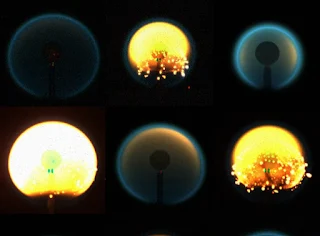NASA showed how flames burn in microgravity!
In microgravity, the flames try to remain in a circular shape.
Humans invented fire centuries ago and it has been used by us for hundreds of years. We are well acquainted with the behavior of fire on earth, but have you wondered how it would behave if the flames were burning in space? The question is not only of curiosity, but also of the safety of the astronauts. Future space missions may face such a challenge. Gravity in space is negligible and flames behave differently in such conditions. In microgravity, the flames try to remain in a circular shape. When a fire burns on the earth, gravity pulls cold and dense air down from the atmosphere and hot gases rise up through the flames. This determines the shape of the flames and makes them unstable.
It is also possible that the change in gravity also affects the process of spreading of fire. Putting out a fire in microgravity can also be a difficult task. NASA is studying this behavior of fire through Advanced Combustion Via Microgravity Experiments (ACME). Astronauts recently completed a project. In which he saw 1500 fires burning in the International Space Station. This was done in a safe and specially designed chamber. But the agency is going to launch a mission on Saturday that will help scientists improve fire safety on the Moon and Mars.
In a recent update on Instagram, the agency also shared a photo that explains how the flames behave in the microgravity environment inside the space station. This will help scientists to design more clean combustion engines on Earth. It has also been written in the caption of the photo that this will help in preparing more safe spacecraft to go to the moon and Mars in future.
According to NASA, the photo shown above is a composite image for which data from 9 different tests has been taken from ACME's Flame Design Experiments. It is also said here that the launch of the cargo ship will take place at 11:9 pm (IST) on Saturday which will carry Solid Fuel Engine Ignition and Extinction (SoFIE). It will help scientists to study flame behavior in microgravity.
Tags:
cambridge science
electrical sciences
genomic sciences
geosciences
life science
live science
neuroscience
science
science magazine
space science
strait of science

